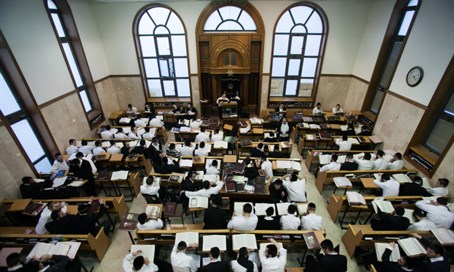An Unequal Share of the Burden? The Truth about the Hesder Yeshivot
One of the objections to the Shaked Committee's legislation for equal sharing of the burden of military service is that students of the religious Zionist hesder yeshivot, which combine Torah study and military service, will only serve for 17 months, whereas their peers will serve for 32. IDI Researcher Dr. Benny Porat does the math based on the current ratio of 16 and 36 months, and comes to an interesting conclusion.

The public outcry about the Haredi draft law is continuing to make huge waves. In the eye of the storm are the students of the hesder yeshivot, who have become the targets of anger from all sides. The students in these religious Zionist institutions, which combine Torah study with military service, are being accused of being draft dodgers, of perpetuating discrimination, and of subjugating the State to religion. In one fell swoop, the hesder program has been demoted from its lofty position as an Israel Prize winner, and its students have been pilloried with the last of the draft dodgers.
The facts indeed seem to speak for themselves. While combat soldiers groan under the burden of 36 months of strenuous service, students in the 5-year hesder program only perform 16 months of actual military service, not even half the amount of regular soldiers. Why, many complain, should we give yeshiva students such a cushy privilege of reduced service?
However, as far as the facts are concerned, the above is only a partial description of the situation and is accordingly also largely inaccurate. One small but crucial fact has been omitted in the storm of debate: the enlistment rate. If we factor in the enlistment rate, we will find that the hesder yeshiva program actually increases, rather than decreases, the number of months of combat service that the Israel Defense Forces receives.
It is no secret that the majority of Israelis of enlistment age do not serve in combat positions; some of them do not enlist at all, each for his or her own reasons, while only a minority of those who do serve in the military serve in combat units. Thus for example, according to data of the IDF Manpower Directorate, some 29% of recruits in Tel Aviv enlist in combat units; in Ramat Gan, the figure is approximately 33%, in Beer Sheva and Rishon Letzion about 34%, and in Netanya about 30%. In contrast, among hesder yeshiva students, the rate of enlistment in combat units is approximately 80%.
If the significance of these figures is not yet clear, perhaps the following example may be helpful. Let's take a representative sample of 10 young men who are graduating from 12th grade in the center of Israel. The combat soldiers among them will indeed serve 36 strenuous months; however, only three of the 10 members of the group are actually likely to enlist in a combat unit at all. Thus, in practice, what the IDF will receive from those 10 young men is 108 months of combat military service. On the other hand, if these same 10 young men were to join the hesder yeshiva program, their rate of service in combat units would skyrocket, and eight of them would become fighters. While it is true that these soldiers will serve in the military for only 16 months within the hesder program, their high rate of enlistment in combat units will yield a total of 128 months of combat service for the IDF. If so, does the hesder arrangement harm the IDF or does it actually strengthen it?
The gap in total combat service grows even larger when we add to the equation the months of service in the reserves that is to be expected of the combat soldiers. If we assume that by the age of 40, the soldiers in question will do about 15 months of reserve duty, the 10 young men in the example above who did not serve in a hesder framework could be expected to contribute 153 months of combat service to the IDF. In contrast, if they were to join a hesder yeshiva, it could be expected that the IDF would gain a total of 248 months of combat service from them.
In other words, the hesder yeshivot succeed in yielding particularly high rates of combat service from recruits—rates that far exceed the value of the reduced period of time that the soldiers actually serve. Dismantling the hesder arrangement will actually decrease rather than increase combat service in the Israeli army. Indeed, there is a reason why the IDF has encouraged the hesder program for so many years.
Is this a sufficient justification for maintaining the hesder yeshivot? Not necessarily. It is possible to argue that even if the IDF benefits quantitatively from the hesder yeshivot, the principle of equality requires uniform service for all. (Thus, for example, if it could be shown that reducing the income tax rate for members of the National Religious community would result in their paying more taxes to the State of Israel, this type of selective discount would be unacceptable nonetheless.) On the other hand, anyone who recognizes the value of Torah study for Israeli society will support the hesder yeshivot, even if this institution causes a certain amount of harm to the quantity of military service and to the principle of equality.
Would it be justified to consider making changes, whether quantitative or qualitative, within the hesder program? It is certainly appropriate to consider changes with an open mind. As for the claim that the hesder yeshivot harm the IDF, however, the facts seem to prove otherwise. The hesder programs increase the quantity of combat service in the IDF; they certainly do not reduce it.
Dr. Benny Porat is a Researcher at the Israel Democracy Institute and a lecturer at the Hebrew University of Jerusalem Faculty of Law.
This article was originally published in Hebrew in the Maariv daily.
